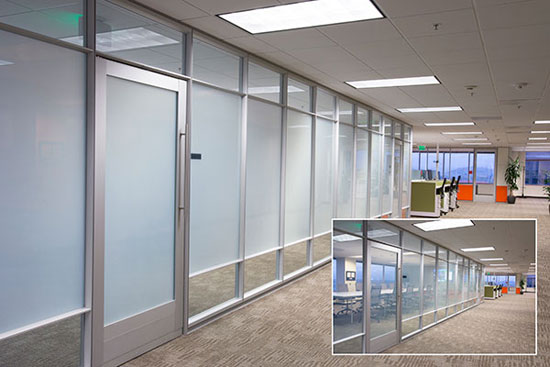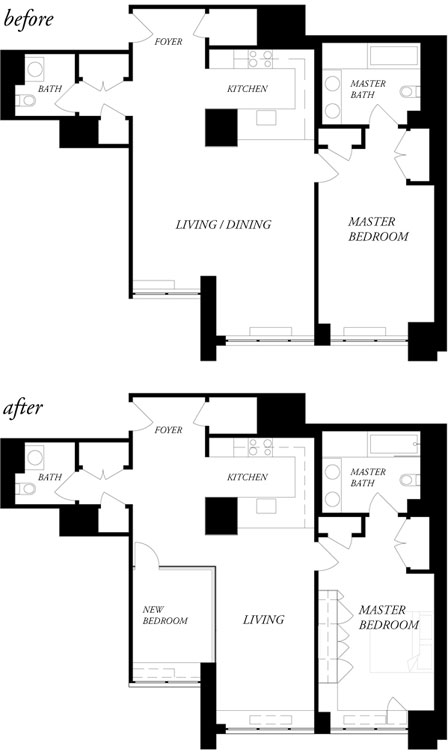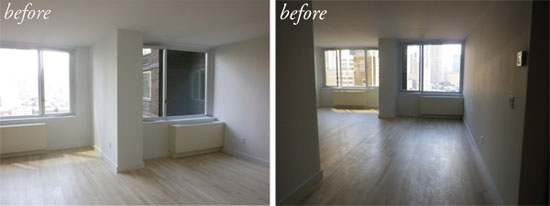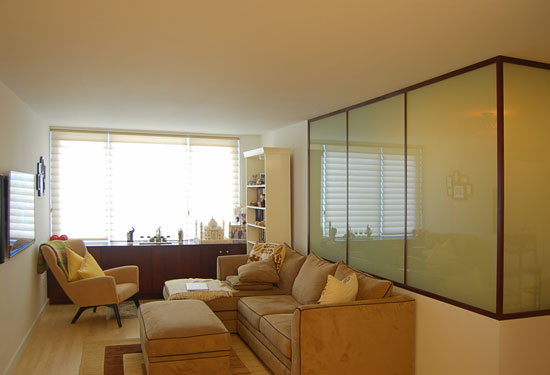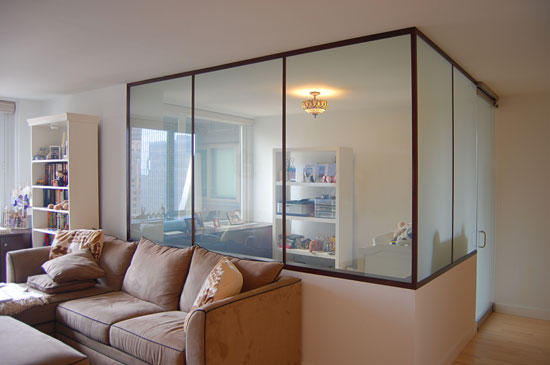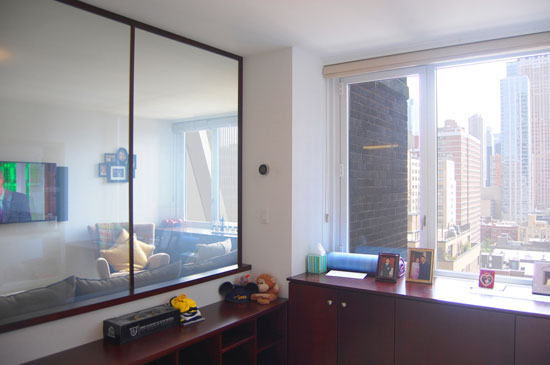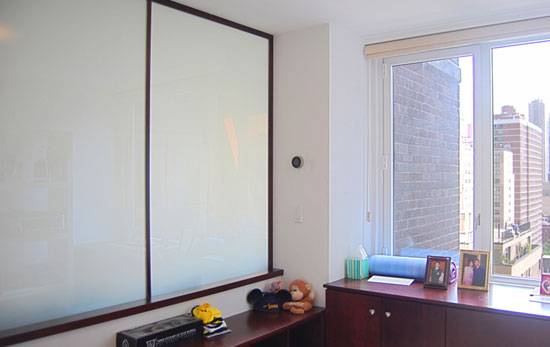Smart Glass Applications with Polymer Dispersed Liquid Crystal (PDLC) Technology
For privacy, energy efficiency, occupant comfort, and display potential
![]() Continuing Education
Continuing Education
Use the following learning objectives to focus your study while reading this month’s Continuing Education article.
Learning Objectives - After reading this article, you will be able to:
- Describe various passive and active smart glass technologies and their appropriate applications.
- Explain how PDLC technology works, including the chemical make-up and reaction when electrical current is applied.
- Discuss privacy, energy use reduction, occupant comfort and other benefits of glazing with PDLC technology.
- Describe real-world application of PDLC technology for privacy, energy savings, light management, and other benefits.
Some 20 years ago, an article appeared in the Chicago Tribune titled “Whatever Happened to 'Smart Window?’”i
Just a few years ago, editor and thinker Geoff Colvin predicted in a Fortune magazine article titled “Brave new work: The office of tomorrow,” that in the future “Offices will be outfitted with special window glass” that can morph into “frosted privacy shades.”ii
Today, the promise of glazing that transforms from transparent to opaque/tinted is finally and firmly here. Not only can the most sophisticated “switchable” glass control the amount of privacy, light, and heat that enters a space, some of the technologies can also function as a rear projection surface for residential home theater display or high-profile corporate and retail display.
Companies have certainly warmed up to smart glass. Those with smart glass installed in their buildings include Google, Bank of America, Disney, Sketchers, Merck, Comcast, eBay, Microsoft, Progressive, IBM, Fox News, and more.
However, some in the design community remain unaware that smart glass refers to various technologies, and that those technologies differ for various best uses.
This article clarifies the diverse technologies used in so-called “smart glass” or “switchable glass,” and the applications where each makes most sense, then narrows the focus onto the properties of polymer dispersed liquid crystal (PDLC) technology. The course covers the privacy, energy efficiency, occupant comfort, and other features of smart glass, and guides the designer and architect on appropriate specification.
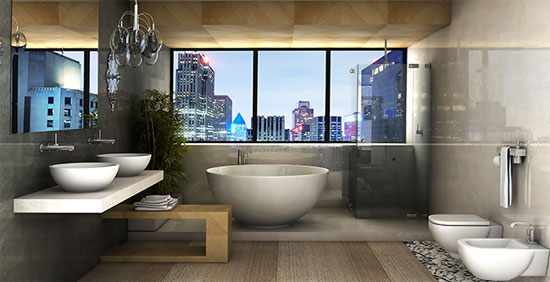
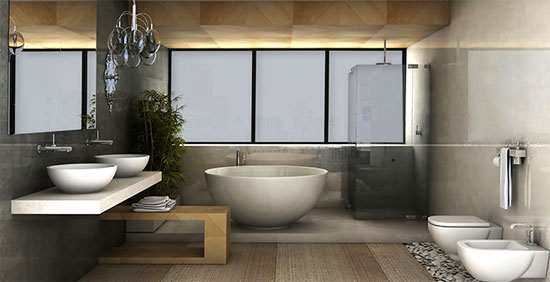
Images courtesy of Glass Apps
Smart glass made with polymer dispersed liquid crystal (PDLC) technology turns glazing from clear to opaque in a split second with the flip of a switch or the tap on a smart phone or tablet.
Applications for PDLC switchable glass range from residential to corporate to health care and retail, while the practical, functional benefits include privacy, display, energy savings, comfort and, it must be said, the wow factor.
That wow factor comes alive in an open-concept law office, for example, where a centrally located conference room bounded by clear glazing becomes a private sanctuary for client meetings and depositions after the glazing turns opaque with the flip of a switch or building system control through automation integration.
In a residential setting, the occupants enjoy unobstructed city or landscape views from extensive lavatory or bathing area glazing, and then enjoy the privacy of opaque/tinted glass when privacy is desired, again with the push of a button or even commands from a smart phone or home automation system.
In retail or health care, spaces are fully exposed or protected with privacy as needs and wants indicate. In retail or auto dealer environments, projected videos can attract customers.
The range of applications for PDLC smart glass will be examined more thoroughly at the end of the course. But first, it’s helpful to understand each of the major technologies used for switchable glass, and to understand the benefits and drawbacks of each technology in order to select the right specification for the project.
Passive and Active Smart Glass Technologies and Their Best Applications
Smart glass technologies include photochromic, thermochromic, electrochromic, suspended particle, and liquid crystal device technologies.

Provided by Glass Apps
While the basic concept behind all smart windows is the same, they can be made in several different ways, each with a different method and properties for blocking light and/or views. Critical aspects of smart glass include material costs, installation costs, electricity costs and durability, as well as functional features such as the speed of control, possibilities for dimming, and the degree of transparency.
Smart glass technologies fall into two categories: passive and active.
Passive Smart Glass Technologies
Passive smart glass technologies respond to non-electrical stimuli and thus cannot be controlled manually. These include thermochromic, which reacts to heat, and photochromic, which responds to light.
A simplistic view of thermochromic windows is that the windows are tinted during the summer and are clear during the winter, with the assumption that thermochromic windows switch based on outdoor air temperature.
Photochromic simply means something that changes color in response to light. In relation to sunglasses, photochromic lenses darken or lighten depending on their exposure to ultraviolet (UV) radiation. Photochromic technology is mostly used in eyeglasses (which tint depending on the amount of light).
With these technologies, glass will limit or expand light transmission depending on the temperature or the amount of light present. For window glass, the timing factor could be problematic. Anyone who has gone from outdoors to indoors wearing these photochromic glasses, and has had to deal with the issue of glasses still darkened from the outside light, could see the advantage of controlling the lightening or darkening depending on one’s needs and circumstances.
Active Smart Glass Technologies
Active smart glass technologies respond to an electrical stimulus and are therefore controllable by the user. They include electrochromic, suspended particle device (SPD) and polymer dispersed liquid crystal (PDLC) technologies.
Electrochromic
Electrochromic uses electricity to turn the glass from clear to dark.
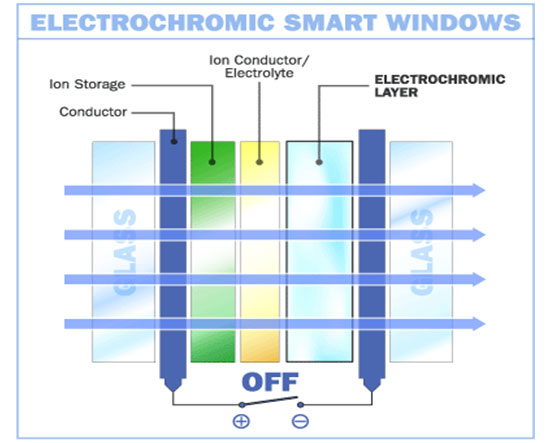

Images courtesy of Glass Apps
Electrochromic glass is typically used for solar control on exterior glass. The visible light transmission in the darkest state can be less than 3%. The resulting shading has limited privacy function as it can still be seen through.
Electrochromic windows consist of two glass panes with several layers sandwiched in between. It works by passing low-voltage electrical charges across a microscopically thin, clear conductive coating on the glass surface, which activates electrochromic layers that change color from clear to dark.
The electric current can be activated manually or by sensors which react to light intensity. One advantage of the electrochromic smart window is that it only requires electricity to change its opacity, but not to maintain a particular shade. This type of technology requires new glass installation, as there is no commercial film option to apply on existing glass.
The switching speed of electrochromic glass is very slow and varies depending upon the size of the panel (larger panels typically take many minutes to switch). The consistency of tint changes also varies, with larger panels sometimes exhibiting tint changes that begin at the glazing’s outer edges and then move inward (known as the “iris effect”).
Suspended Particle Device Technology
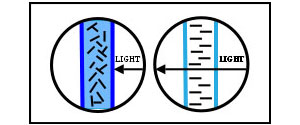
Image courtesy of Glass Apps.
In SPD technology, when voltage is applied, the suspended particles align and let light pass.
Suspended particle devices (SPDs) respond to AC power to turn the glass from dark to clear.
SPDs are ideal for such light control applications as skylights, auto glass, sunroofs, aircraft windows, and marine windows and portholes.
In suspended particle devices (SPDs), a thin film laminate of rod-like nano-scale particles is suspended in a liquid and placed between two pieces of glass or plastic, or attached to one layer. When no voltage is applied, the suspended particles are randomly organized, thus blocking and absorbing light. When voltage is applied, the suspended particles align and let light pass. Varying the voltage of the film varies the orientation of the suspended particles, thereby regulating the tint of the glazing and the amount of light transmitted. The visible light transmission at the darkest state of SPD glazing is around 0.5% and the process takes one to three seconds after power is applied, regardless of the size of the window. The resulting dark blue shading blocks light and provides only partial privacy.
Polymer Dispersed Liquid Crystal Switchable Technology
The third type of active smart glass technology, and the focus of this learning unit, is polymer dispersed liquid crystal (PDLC). This technology controls light diffusion to turn the glazing from opaque to clear using AC power. In this technology, the glazing goes from opaque to clear or from clear to opaque in milliseconds, regardless of the window size.
In the opaque state, more than 96% of the parallel light is blocked resulting in excellent privacy although around 80% of the total light transmits through the glazing. When switched to clear, you can see through the material like a piece of glass with about 86% total light transmission. We’ll examine how this technology works in the next section.
How PDLC Technology Works
Liquid crystal applications are a familiar technology for numeric and flat panel displays. Liquid crystal display, or LCD, is the most popular flat panel display technology, seen in portable computers, cell phones, calculators, digital clocks, gas pumps, and watches, etc. In LCD, applied electricity changes the shape of liquid crystals to allow light to pass through individual elements, thus forming images, figures, and numbers on the displays.
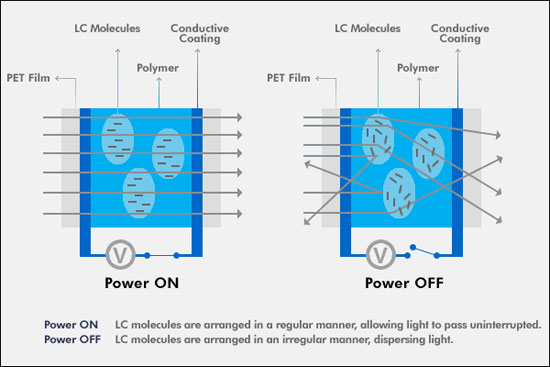
Image courtesy of Glass Apps.
Liquid crystals respond to an electrical charge to morph the glass from opaque to clear.
Source: http://www.glass-apps.com
Polymer dispersed liquid crystal is simply micro droplets of liquid crystals encapsulated in a polymer matrix. The liquid crystals respond to an electrical charge. In a static state, the liquid crystal molecules remain in a randomized configuration that refracts the light that enters the mixture, making it appear opaque. When electricity is applied, the molecules line up the direction of the electric field, allowing light to pass through what is now essentially a transparent surface. When electrical charge is deactivated, liquid crystal droplets again become randomly oriented, the incoming light is again heavily scattered and does not pass through in a straightforward manner, resulting in fully blocked images.
Types of PDLC Switchable Glass
Smart glass with PDLC technology is available in two separate products that help to solve distinct design problems.
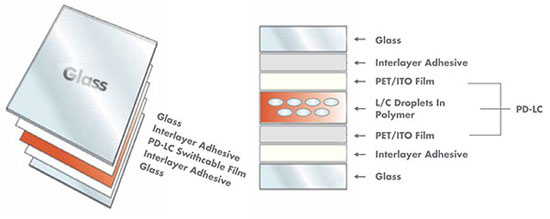
Image courtesy of Glass Apps
The layer containing indium tin oxide (ITO) conducts the electricity that stimulates the liquid crystals.
Laminated Switchable PDLC Glass
Laminated switchable glass is typically used for new construction projects or renovations where glass may be replaced. In this case, switchable film is sandwiched between two sheets of glass and two sheets of interlayer adhesive. Indium tin oxide (ITO) is a clear conductor that is coated on the inside of PET plastic films, which are sandwiched around the LC droplets encapsulated in a polymer matrix. PET/ITO films conduct the electrical current that causes the liquid crystals to align and thus render the glass transparent. Glass can be made to almost any thickness (5/16” to + for Insulated Units) and specification required (i.e. tempered, low-iron, etc.).
Self-adhesive Switchable PDLC Film
Self-adhesive switchable film is typically used for retrofit applications. Switchable adhesive film has an adhesive side that is dry applied to the surface of any smooth glass surface (similar to a smart phone screen protector) and can be easily installed in the field. The outer surface of the film is hard coated and scratch resistant. Copper mesh tabs on the top or sides connect the conductive layer to electrical wires soldered on by the installer, covered by a silicone bead, and attached to a power source. The electrical current can be controlled by a wall switch, home automation or smart phone app.
With the knowledge of how PDLC technology works, we’ll next examine the benefits it brings.
Privacy, Occupant Comfort, Energy Use Reduction with PDLC Technology
PDLC switchable glass is a solution for privacy, heat, and light management. When opaque, PDLC switchable glass provides full privacy. By the nature of the liquid crystal droplets, privacy is achieved while still allowing the vast majority of available light to enter the space, creating a private environment with the benefits of natural light. This contributes to environments that have open floor plans where natural light can penetrate deep into the space. Additionally, switching from opaque to clear in less than a second makes it an instant privacy solution.
PDLC switchable glass typically blocks 99% of UV rays, which cause damage and discoloration of interior walls, carpets, and furnishings.
In its opaque state, PDLC smart glass can reduce solar heat gain by up to 40%. The reduced heat gain in hot months helps keep the interior cooler, thus requiring less air conditioning producing increased occupant comfort, and providing cost savings.
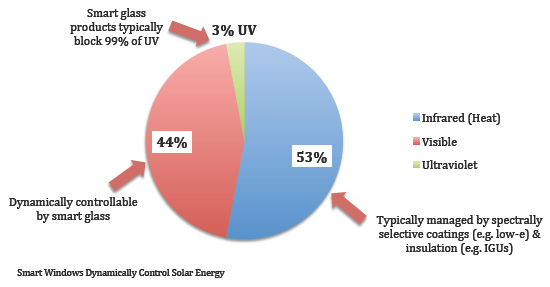
Image courtesy of Glass Apps
Exterior Glazing Applications
While the past few decades have seen elevation of the idea of “smart buildings,” there can be no such thing unless the envelope itself is smart, ideally able to change properties as exterior light and temperature changes. Switchable glass offers that possibility. Here are some benefits:
Contributes to a modern environment — While certain architectural styles may lend themselves to heavy drapery and blinds, the modern aesthetic is a perfect match for switchable glass. Far from weakening contemporary interior styles, PDLC switchable glass adds value to them. Aside from aesthetics, PDLC switchable glass can be used in conjunction with automation systems, contributing to a connected/interactive home or office.
Improved air quality — PDLC switchable glass reduces the need for dust-collecting drapery, which can add greatly in the quest for superior air quality. It is not uncommon during summer and winter months to have air recirculating through a space. With the removal of bacteria and dust collecting materials such as drapery, much of the harmful dust and allergens are easily removed from the space.
Or, in homes or environments where drapery, blinds, or other window coverings are preferred, switchable glass provides another level of heat and UV protection and privacy.
Interior Applications
Creates flexible use of space — The example of a corporate board room mentioned earlier illustrates the ability for a space to be open at times and private at times, as needs dictate. Because we, as humans, are programmed by our history and our buildings to think of partition walls and doors as either solid or transparent, pondering the potential for glass that can switch from one to the other does not come naturally.
Creates privacy when needed — PDLC switchable glass can be used to partition parts of the bathroom, for instance, such as the lavatory and bathing area. Thus, in its transparent phase, the smart walls allow for the feeling of an expansive room, and in their opaque phase provide privacy without blocking light.
Compatible with home and building automation systems — While a switch on the wall or on the device seems the natural way to control electrical elements in a building, PDLC switchable glass can be controlled from an iPad, smart phone, or other wireless function. This will appeal to forward-thinking owners, and those who seek to be ahead of the latest movements in home and office automation.
Rear projectable display — This capacity allows the glass to transform storefront windows with full motion graphics for a fraction of the cost of LCD displays. Or, the owner can create eye-catching patterning and motion effects or touchscreen interactive experiences. One example is the BMW Osaka dealership. To attract customers, rear projected videos show the brand’s interior features and then segue to a heart-racing driving scene, and then back to the car’s exterior.


Photos courtesy of BMW Osaka
This BMW dealer uses PDLC switchable glass for rear projection to catch the eye of passersby.
Real-World Application of PDLC technology
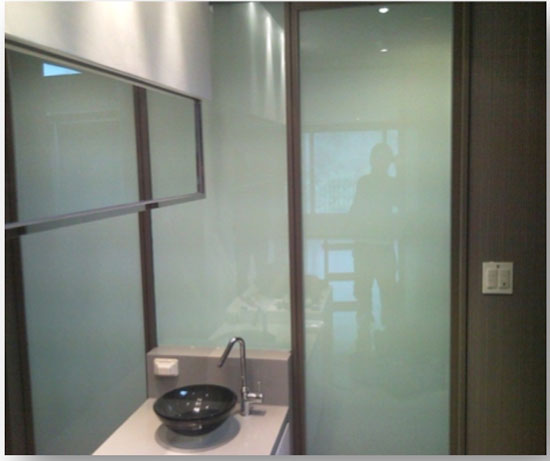
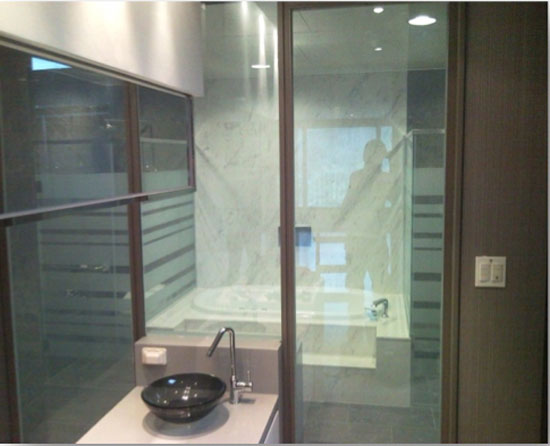
Photos courtesy of Glass Apps
With PDLC smart glass, sections of a bathroom can have privacy or openness as needed, without blocking all the natural light.
Residential – Bathrooms
The design of bathrooms usually brings about a choice: open or enclosed spaces? In an open concept bathroom, the toilet area, bathing area, and sink area are all part of one big space. This creates a comfortable openness, but allows for little or no privacy for each function. The choice to enclose various bathroom functions within partition walls brings the desired privacy, but creates cut-off spaces. With the option of PDLC switchable glass partition walls, both goals—openness and privacy—can be achieved as desired.
Wide-Ranging Applications
Residential – Exterior Facing Windows
Until recently, options for exterior-facing windows left the user with two options: open views to the outside, or closed off view/light via window coverings. These two narrow choices drive many aspects of residential design, from siting to orientation to size and amount of glazing. With PDLC switchable glass comes more choices. A room with extensive glazing can be both brightly lit with natural light as well as private to passersby. PDLC technology offers full privacy as well as a luminous interior when in its off state.
Hotel / Restaurants
Customer satisfaction and profit margins are the engines driving the hospitality industry. PDLC switchable glass offers occupant comfort and privacy, as well as lowering energy costs, dispensing of the need for expensive window coverings, and providing an enhanced, high-technology image for the property. Plus, walls, carpeting, and furnishings escape damage from UV rays when smart glass is installed. In addition, many hotels and restaurants aim to stay ahead of the curve and offer the latest in modern trends, and nothing says ahead of the curve more than PDLC switchable glass, which brings a definite wow factor.
Conference rooms
For a well-equipped office, a dedicated conference room is a must. But when no private conferences, meetings, or depositions are in session, that high-priced real estate remains cut off and reduces available light and openness. PDLC switchable partition glass allows the conference area to remain a visual part of the open office, allowing natural light to both flow into the space from adjacent naturally lit areas, and to flow out of the room into adjacent spaces.
Privacy
Privacy via window coverings is often achieved at the cost of natural light. Once the window is covered, the light is blocked. Smart windows using PDLC technology allows for privacy as well as natural lighting.
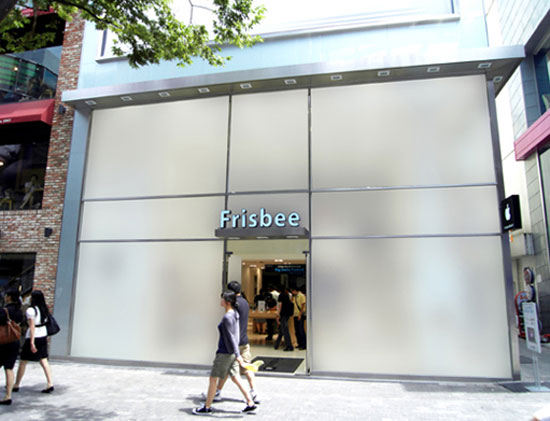
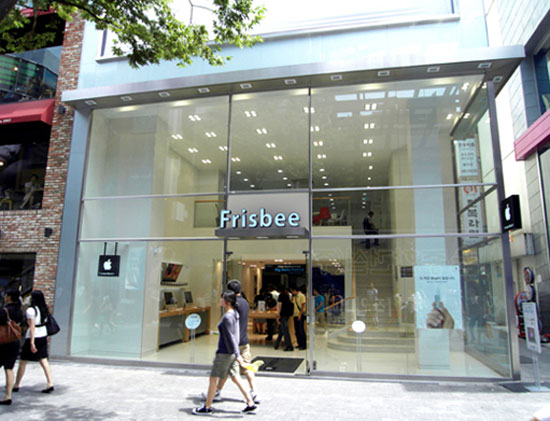

Photos courtesy of Glass Apps
To grab the attention of passing traffic, this retailer uses smart glass that switches from clear to opaque in patterns. The attention from passersby greatly increases in-store traffic. Additionally, the panels can be used in the evening to project HD quality video, creating a video advertising experience that contributes to branding and thus greater in-store traffic.
Retail
The possible uses for retail applications are virtually unlimited. One upscale clothing retailer with a front wall of glazing used smart glass to allow clear glass during shady times and opaque glass during sunny times. The panels changing from transparent to opaque give the store a higher-end, chic ambiance. In addition, to the wow factor, the UV protection achieved by using the PDLC switchable glass reduces the likelihood of sun damage to merchandise displayed behind the windows.
Projection
PDLC is a close cousin to the LCD technology that brings alive our computers, flat-screen TVs, iPads, and other daily gadgets. PDLC switchable glass allows for small or large glass surfaces to be used for dramatic rear projection displays. BMW uses this striking technology in showrooms to bring to life the drama of driving their luxury automobiles. This not only provides a unique advertising medium, but also allows the glass to serve a dual purpose. During the day, the PDLC switchable glass can be clear, allowing full visibility into the showroom, and in the evening the PDLC switchable glass switched to projection to attract attention.
Hospitals and Clinics
Smart glass provides an alternative to dust- and bacteria-trapping blinds and curtains, and thus offers privacy and openness with natural lighting and views when desired while maintaining a sterile environment. Bacteria and germs inside hospitals is a major and growing problem, leading to one in 25 patients getting an infection while in the hospital. That equals, according to a study in the New England Journal of Medicine, 721,800 hospital-acquired infections resulting in some 75,000 deaths.iii Replacing dust- and bacteria-carrying materials with smooth, easy-to-clean glass, this problem can be mitigated substantially.
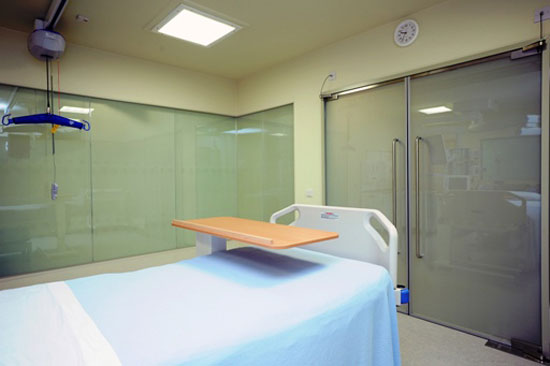
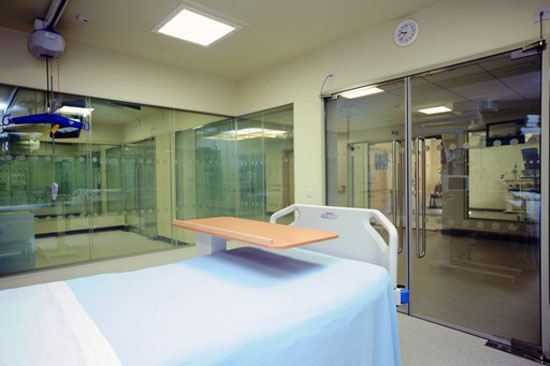
Photos courtesy of Glass Apps
Strategies to reduce pollutant-carrying materials such as curtains, while allowing the maximum flow of light, could include PDLC smart windows.
Conclusion
The long wait for smart glass is over. The technology is here. The main task ahead is changing a mindset that all walls are solid and all windows are transparent. With smart windows using polymer dispersed liquid crystal technology, a new design strategy is open to designers. With such benefits as privacy with visible light transmission, occupant comfort, improved air quality, energy savings, a contemporary aesthetic, and capacity for rear projection, smart glass will likely become a staple of design specifications in the future.
Endnotes
ii. http://www.geoffcolvin.com/fortune_articles/article/brave-new-work-the-office-of-tomorrow/
iii. http://www.cnn.com/2014/03/26/health/hospital-infections/
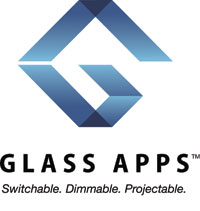 |
Glass Apps is the leading provider of switchable glass and liquid crystal based films. Our smart glass and film products provide privacy on demand with the switch of a button and energy savings through solar control. Glass Apps products are used in residential, commercial, retail, government and transportation exterior and interior glass worldwide. Glass Apps is headquartered in Culver City, CA. |

